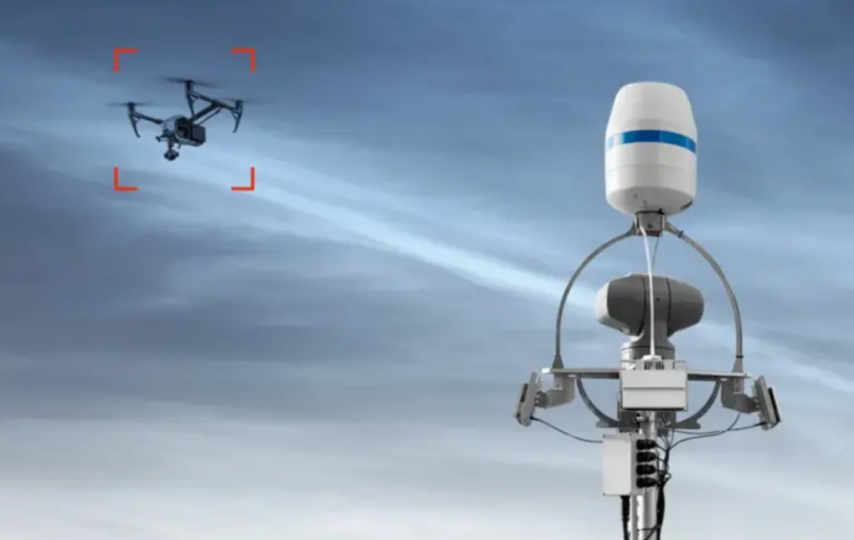Drones have buzzed in our lives with multiple advantages. From freeing aerial imagery to optimizing deliveries, these untamed machines have become popular. Nevertheless, there is a flip side to their adorable appearance. When used mistakenly, these versatile gadgets can be transformed to cause disturbance and even havoc.
Unauthorized use of drones can spoil critical infrastructure, break privacy rights, and even be applied for criminal purposes. The use of a specific counter-drone solution is imperative in securing our skies from these increasing dangers.
Counter-drone DTI Capabilities
As drones have great potential, they may also pose serious security threats. DTI (Detect, Track, Identify) functions are the backbone of successfully fighting them. Now let’s go through different DTI technologies that protect us from airspace threats.
Radar Systems
Two primary technologies form the foundation of drone detection: radar and radio frequency (RF) detection. Radars are like the sonar systems. They emit radio waves that bounce off objects and return information about the objects’ location, size, and movement. They are powerful sets of tools that have been conveniently designed to function in low-light or poor weather conditions offering thorough and widespread situational awareness.
On the other hand, conventional radar systems can have difficulty detecting small drones, particularly those made of composite materials with low radar signatures. Discriminating drones from other flying objects such as birds is also one of the problems.
RF detection constitutes an additional means that works on the detection of the radio signals between the drone and its controller. This technology has the ability to distinguish different types of drone communication protocols and can even look through visual obstacles.
Drones, utilizing encryption or signal-jamming technologies, can bypass detection, and other types of radio frequency noise can be concealed.
Optical and Acoustic Sensors
Sensors are the main part of many drone detection systems. This diverse group includes high-resolution cameras that can visually identify and track drones even going as far as to provide details like model and payload.
Thermal imaging systems have an edge in detecting drones in low-light conditions where traditional cameras could have problems. Acoustic sensors are very important in terms of pinpointing the unique sound of a drone’s rotors and detecting it for possible localization. Nevertheless, these technologies have their shortcomings.
Adverse weather conditions such as fog or darkness might obstruct the operation of these sensors while acoustic detection might confuse drone noise with other sounds.
None of the DTI technologies can promise a complete remedy. Nevertheless, through blending the techniques and weaving together their data, we came up with a system for detecting, tracking, and identifying the drones that are out of control. Such comprehensive measure is the core of an effective counter-drone method.
Counter-Drone Technologies by Function
The issue of drone threats calls for a holistic approach to counter the threats. Counter-drone technologies can be broadly categorized based on their function: Disruption and Neutralization. Let’s look at these categories and the technologies it encompasses.
Technologies for Disruption
They eliminate the connection between a drone and the operator, thus, preventing its further flight. Radiofrequency jamming interferes with the radio frequency signals, which are the most critical for voice and data communications. This means that the pilot’s orders cannot be delivered to the drone.
GPS spoofing employs a different tactic: It disrupts the drone’s navigation system by emitting false GPS signals. This puts the drone’s sense of direction off balance, resulting in it possibly forgetting its location and going back to the starting point.
Technologies that Neutralize Drones
Neutralization technologies either permanently or temporarily terminate drones and interfere with their physical capacity. One way employs directed energy weapons, like high-powered lasers or microwave devices. Such weapons destabilize drone electronics or flight control systems and therefore easily and quickly render a threat ineffective.
Conclusion
An effective anti-drone solution is situation-specific. Factors like the type of drone threat, the weather, and the ultimate aim all affect the choice of the correct technology.
Along with these advances in drone technology, new tactics for its misuse will also emerge. Disruption methods can become less effective because drones with anti-jamming technologies are becoming more available. Similarly, the neutralization strategies have to be modified to counter different drone designs or functions.
We can make the skies friendly to legitimate drone operations by accepting the changing nature of threats, funding further studies and innovations, and dealing with the ethical problems of counter-drone techniques.







